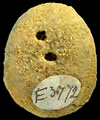The Echinoid Directory
Contributed by Jenna Sullivan, April 2007
Australanthus florescens (Gregory 1892, p. 435)
[Cassidulus florescens Gregory 1892, p. 435, pl. 12, figs 1-4.]
| Diagnostic Features |
|
|---|---|
| Distribution | Janjukian, Port Addis Limestone, Upper Oligocene-earliest Miocene, Fyans Ford Hill, Moorabool River, northwest of Geelong, Australia. |
| Type | Natural History Museum syntypes E3771- E3773. |
| Classification and/or Status | Species of Australanthus. |
| Remarks | Differs from Cassidulus faba in the petal structure: petals of Cassidulus faba are longer and almost entirely closed, while petals of Cassidulus florescens are almost open. Anus of Cassidulus florescens is longer and narrower, and the test higher [from Gregory 1892]. Holmes (1999) records this species from the Port Addis Limestone close to the type locality. Gregory, J. W. 1892. Further additions to Australian fossil Echinoidea. Geological Magazine decade III, 9, 433-438, pl. 12. Holmes, F. C. 1999. Australian Tertiary Apatopygidae (Echinoidea). Proceedings of the Royal Society of Victoria 111, 51-70. |







